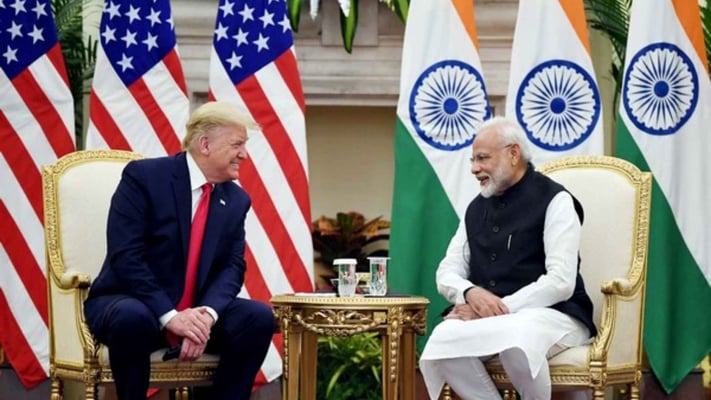India Launches Steps To Counter US Tariff Hike

New Delhi is doubling down following the Trump administration’s
steep tariff hike on Indian imports to the US, which kicked in on Wednesday.
Washington’s 50% import duty hike on Indian goods will hit sectors
such as textiles, gems and jewellery, shrimp, leather, footwear, chemicals and machinery.
But India is looking at alternative markets to cushion the impact of the tariff burden imposed by the US on the Indian economy.
India is targeting 40 select markets from among the over 220
countries it currently exports to. These markets, which include the
UK, Japan, South Korea, Germany, France and Australia, gain
importance as New Delhi steps up its diversification drive to counter the Trump administration’s trade offensive.
India is looking to expand its market share in these countries whose combined annual net import of textiles and garments tips US $ 590 billion. India’s market share stands at 5-6%. The diversification drive will be borne by the Export Promotion Councils ( EPCs).
But there are unwelcome spinoffs for India in the Trump
administration’s latest move. The additional tariff on Indian imports into the US gives a cost advantage to competitors such as Vietnam, Sri Lanka, Bangladesh, Cambodia and Indonesia.
The garment industry had barely adapted to the 25 per cent reciprocal tariff initially announced by the US. But raising the burden by another 25 per cent has effectively priced Indian apparel out of the US market.
India is now looking to leverage its trade deals with partners such as the UK. The tariff shock is across sectors: jewellery ( valued at $ 28.5 billion) , sea food ($7.4 billion) leather and footwear ($4.1billion).
Industry data puts Indian exports to the US at $ 86.5 billion annually.
Trump’s new tariff regime will impact an estimated 66% of that trade output.
Pharmaceuticals, electronics and petroleum products are exempt from duty, for now.
The destabilising impact of the punitive tariff hike could include job losses in the affected sectors as well as lowered GDP.
The tariff shock softens the pitch in favour of the US in upcoming
trade negotiations between the two countries. But Washington will be looking for greater concessions in the farm sector that New Delhi is disinclined to grant.
But the overriding pretext for the 50% tariff hike on Indian exports to the US is Trump’s perception that India’s purchase of discounted
crude from Russia is fuelling the war in Ukraine.
The geopolitical compulsion behind the executive order issued by
Trump, raising the total tariff on Indian imports to the US to 50%,
was aimed at pressuring Russian President Vladimir Putin into calling a ceasefire in Ukraine, as well as unlocking New Delhi from the Kremlin’s embrace.
Neither objective was achieved.
The Trump-Putin summit in Alaska was inconclusive and the war in Ukraine rages on. India’s foreign ministry responded to Trump’s
executive order on tariffs with a terse statement saying : “India will
take all actions necessary to protect its national interest.”
Russian crude accounts for over 30% of India’s supplies, making
Russia its main supplier.
Trump and Indian Prime Minister Narendra Modi have a history of
cordial relations. But the current face-off suggests ties between
Washington and New Delhi have hit a fork on the road.
Venu Menon is a senior journalist based in Wellington. He was
Consulting Editor of The Hindu in India prior to moving to New
Zealand.
New Delhi is doubling down following the Trump administration’ssteep tariff hike on Indian imports to the US, which kicked in on Wednesday.Washington’s 50% import duty hike on Indian goods will hit sectorssuch as textiles, gems and jewellery, shrimp, leather, footwear, chemicals and machinery.But...
New Delhi is doubling down following the Trump administration’s
steep tariff hike on Indian imports to the US, which kicked in on Wednesday.
Washington’s 50% import duty hike on Indian goods will hit sectors
such as textiles, gems and jewellery, shrimp, leather, footwear, chemicals and machinery.
But India is looking at alternative markets to cushion the impact of the tariff burden imposed by the US on the Indian economy.
India is targeting 40 select markets from among the over 220
countries it currently exports to. These markets, which include the
UK, Japan, South Korea, Germany, France and Australia, gain
importance as New Delhi steps up its diversification drive to counter the Trump administration’s trade offensive.
India is looking to expand its market share in these countries whose combined annual net import of textiles and garments tips US $ 590 billion. India’s market share stands at 5-6%. The diversification drive will be borne by the Export Promotion Councils ( EPCs).
But there are unwelcome spinoffs for India in the Trump
administration’s latest move. The additional tariff on Indian imports into the US gives a cost advantage to competitors such as Vietnam, Sri Lanka, Bangladesh, Cambodia and Indonesia.
The garment industry had barely adapted to the 25 per cent reciprocal tariff initially announced by the US. But raising the burden by another 25 per cent has effectively priced Indian apparel out of the US market.
India is now looking to leverage its trade deals with partners such as the UK. The tariff shock is across sectors: jewellery ( valued at $ 28.5 billion) , sea food ($7.4 billion) leather and footwear ($4.1billion).
Industry data puts Indian exports to the US at $ 86.5 billion annually.
Trump’s new tariff regime will impact an estimated 66% of that trade output.
Pharmaceuticals, electronics and petroleum products are exempt from duty, for now.
The destabilising impact of the punitive tariff hike could include job losses in the affected sectors as well as lowered GDP.
The tariff shock softens the pitch in favour of the US in upcoming
trade negotiations between the two countries. But Washington will be looking for greater concessions in the farm sector that New Delhi is disinclined to grant.
But the overriding pretext for the 50% tariff hike on Indian exports to the US is Trump’s perception that India’s purchase of discounted
crude from Russia is fuelling the war in Ukraine.
The geopolitical compulsion behind the executive order issued by
Trump, raising the total tariff on Indian imports to the US to 50%,
was aimed at pressuring Russian President Vladimir Putin into calling a ceasefire in Ukraine, as well as unlocking New Delhi from the Kremlin’s embrace.
Neither objective was achieved.
The Trump-Putin summit in Alaska was inconclusive and the war in Ukraine rages on. India’s foreign ministry responded to Trump’s
executive order on tariffs with a terse statement saying : “India will
take all actions necessary to protect its national interest.”
Russian crude accounts for over 30% of India’s supplies, making
Russia its main supplier.
Trump and Indian Prime Minister Narendra Modi have a history of
cordial relations. But the current face-off suggests ties between
Washington and New Delhi have hit a fork on the road.
Venu Menon is a senior journalist based in Wellington. He was
Consulting Editor of The Hindu in India prior to moving to New
Zealand.










Leave a Comment